- Aviator Xpro gives excellent control of the key diseases of wheat, barley and triticale to deliver high yields and an attractive return on investment.
- Aviator Xpro’s Leafshield formulation technology maximises the number of days when spraying is possible. Containing specially designed adjuvants, Aviator Xpro spreads evenly on the leaf, dries quickly and is rainfast once dry on the crop under most circumstances.
- Aviator Xpro is the easy way to apply a ready-mixed formulation of both a DMI and SDHI fungicide. As well as reducing the complexity of stocking multiple fungicides – less partially used containers, less plastic waste, less risk of applying the wrong rate, it means that you are applying two modes of action in a tested ratio which helps reduce the risk of fungicide resistance developing.
- Aviator Xpro was developed in New Zealand under our conditions by Bayer’s expert field solutions team. Together this ensures Aviator Xpro and the Bayer field team will deliver maximum value for you.

- Home
- Products
- Fungicides
- Aviator Xpro

Aviator Xpro
Aviator Xpro is a protective and curative high performing fungicide for use in wheat and barley which combines two complimentary fungicides, prothioconazole (DMI) and bixafen (SDHI), in a convenient ready mixed formulation. Its innovative Leafshield™ formulation ensures even leaf distribution and rapid rainfastness.
-
Benefits
-
Crop Suitability & Usage
-
Resources
| Crop | Diseases Controlled |
|---|---|
| Barley | Scald, net blotch, ramularia leaf spot, leaf rust |
| Wheat | Speckled leaf blotch, stripe rust, leaf rust |
| Triticale | Stripe rust, leaf rust |
| Product Type | Fungicide |
| Active Ingredient | Bixafen 75 g/L Prothioconazole 150 g/L |
| Formulation Type | Emulsifiable concentrate |
| Pack Size | 10 litres |
| Application Rate/Timing | Apply 700 ml - 1.0 L/ha in 120 L/ha water at the first signs of disease. Re-apply 3-4 weeks later if required. |
| Application Method | By tractor mounted hydraulic boom sprayer or by aerial application. |
| Water Rate | 120 L/ha water by ground application or 50 L/ha by aerial application |
| Rainfastness | Rainfast once dry on the leaf under most conditions when applied to a dry crop |
| Withholding Period | Wheat, barley and triticale (grain): 56 days Wheat, barley and triticale (forage): 42 days |
| No. Applications/Crop | Maximum two per crop |
| Compatibility | Compatible with a wide range of commonly used fungicides and insecticides |
| Certified Handler | Not required |
No results for this category. Please select a different one.

Aviator Xpro Label

Aviator Xpro SDS

Aviator Xpro HazNote

Cereal Disease iGuide
Latest Aviator Xpro news
Related Pests
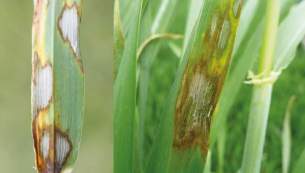
Scald
Rhynchosporium secalis
Scald (Rhynchosporium secalis) is a common disease of barley which can result in significant yield loss if not controlled. Scald is favoured by cooler, moist conditions with the initial source of inoculum being infected straw
debris. The first symptoms often appear during winter or early spring, initially as pale greyish lesions which then develop a more straw coloured appearance with a defined dark edge to the lesion.
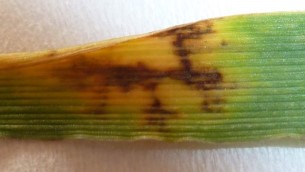
Net Blotch
Pyreophora teres
Net blotch (Pyreophora teres) is a common disease of autumn sown barley (much less commonly spring sown barley) which can result in significant yield loss if not controlled. Charateristics net type lesions
give the disease its common name but lesions can also take the form of dark stripes and streaks and when infection is severe in large dead areas of leaf. Infection sources are either seed or crop debris, which is borne out by second year barley crops being likely to carry infection. Net blotch development is favoured by cool, moist conditions.
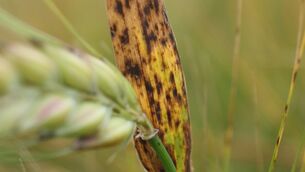
Ramularia Leaf Spot
Ramularia collo-cygni
Ramularia leaf spot (Ramularia collo-cygni) is a common disease of barley which can result in significant yield loss if not controlled. While both winter and spring planted barley can be affected, the impact of Ramularia is
usually greater on winter planted crops. Ramularia is seed borne and once the fungus has infected the plant it grows within the plant, not producing visible symptoms until around ear emergence. Symptoms consist of small brown lesions which under the right conditions can rapidly increase and coalesce together.
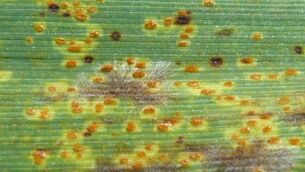
Leaf Rust - Barley
Puccinia hordei
Leaf rust (also known as brown rust) is a disease of barley. Whilst occurring less frequently than leaf rust in wheat it can result in significant yield loss if not controlled. Leaf rust is favoured by
warmer, drier conditions with the initial source of inoculum being infected volunteer cereals. Under favourable conditions leaf rust can develop very quickly. Spores are scattered at random on the leaf and are often surrounded by a pale chlorotic halo.
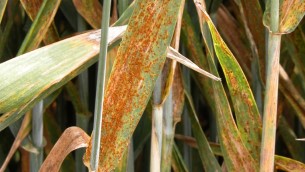
Leaf Rust - Wheat
Puccinia triticina
Leaf rust (also known as brown rust) is a common disease of wheat which can result in significant yield loss if not controlled. Leaf rust is favoured by warmer, drier conditions with the initial
source of inoculum being infected volunteer cereals. Under favourable conditions leaf rust can develop very quickly. Spores are scattered at random on the leaf and are often surrounded by a pale chlorotic halo.
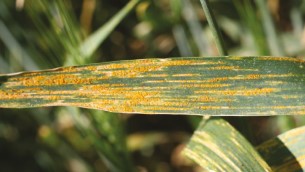
Stripe Rust - Wheat
Puccinia striiformis
Stripe rust (Puccinia striiformis) also known as yellow rust, is a common disease of wheat which can result in significant yield loss if not controlled. Stripe rust is favoured by cooler, moist conditions with the initial
source of inoculum being infected volunteer cereals. Under favourable conditions stripe rust can develop very quickly forming disease foci surrounding the initial infection source. At first spores tend to be scattered on the leaf but on more mature leaves they show the typical stripe arrangement which gives the fungus its common name. Occasionally stripe rust can infect the ear.





